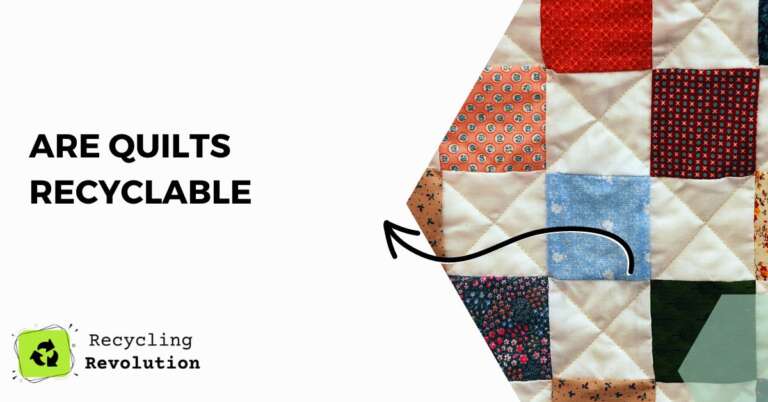It’s an age-old question for any eco-conscious individual or quilt lover: are quilts recyclable? From a broad perspective, the answer is yes, but the process isn’t always as straightforward as recycling a plastic bottle or newspaper. It largely depends on the material make-up of the quilt, the condition it’s in, and the recycling facilities available in your area.
TL;DR: While quilts aren’t typically recyclable in the traditional sense, many components can be reused, repurposed, or even composted under the right conditions. Donating, repurposing, and composting are some of the most environmentally friendly ways to deal with old quilts.
Material Matters
To understand why quilts present a unique challenge for recycling, we need to first break down their construction. The average quilt is made up of three layers:
- The top, which is often pieced together from various fabrics, frequently cotton or polyester.
- The middle, known as batting or wadding, which provides insulation and thickness. This layer can be made of cotton, polyester, wool, or even bamboo fibers.
- The backing, which is typically a single piece of fabric.
Each of these layers presents unique challenges when it comes to recycling.
The Challenge With Mixed Material Recycling
Quilts, especially those that are handmade, often incorporate a mix of materials. While cotton and wool are both naturally biodegradable, synthetic fibers like polyester aren’t. Mixed material items can be particularly challenging to recycle, as separating the different components is often not feasible.
For quilts made primarily of natural fibers, composting might be an option, but this wouldn’t be suitable for quilts containing synthetic materials.
Alternative Routes: Donate, Repurpose, Compost
If the traditional recycling route isn’t a viable option for your quilt, fear not. There are still several ways to ensure your quilt has a life beyond your use, minimizing its environmental impact.
Donations
I recommend considering donation as your first port of call. Quilts in good condition can provide comfort for those in need. Check with local homeless shelters, animal shelters, and charities like Goodwill and Salvation Army.
They often welcome quilt donations, especially during colder months. Visit your local food banks to learn more about the organisations in your area that are looking for these donations, they would be much appreciated.
Repurposing
If your quilt isn’t in a suitable condition for donation, repurposing could be an option. Old quilts can be turned into smaller items like cushion covers, bags, or even clothing.
They can also serve a utilitarian purpose in your home, serving as a protective cover for furniture during a move, or as a drop cloth for painting projects.
Composting
For quilts made of organic material like cotton or wool, composting can be an excellent disposal method. You would need to separate the organic material from any non-compostable components, such as synthetic fibers or metal embellishments.
Once you’ve done that, you can shred the organic material and add it to your compost pile.
Deeper Into Recycling: Fabric Specifics
In the quest to answer the question “Are quilts recyclable?”, understanding the specifics of individual fabrics used in quilt-making is essential. This can guide you towards more environmentally-friendly choices when creating or purchasing a quilt and help you determine the best disposal method when the time comes.
Cotton and Wool: Nature’s Gift
Natural fibers such as cotton and wool are both biodegradable and compostable. Over time, these materials break down naturally, returning to the earth without leaving harmful residues. If your quilt is made purely from these materials, and colored with natural dyes, it can be composted at home.
Note: However, this doesn’t mean you should compost quilts en masse. Home composting systems have their limitations, and adding a large quilt might upset the balance of your compost pile. It’s best to cut the quilt into smaller pieces and add them gradually over time.
Synthetic Fibers: A Recycling Challenge
On the flip side, synthetic fibers such as polyester, nylon, or rayon present a greater challenge. These materials are derived from petroleum and don’t biodegrade or compost easily.
For quilts made from or containing synthetic materials, the best option currently is to extend their life as much as possible. This could be through repurposing, repairing, or donating them when you no longer need them.
Clothing and Textile Recycling Programs
Though not yet widespread, there are textile recycling programs that can handle mixed materials. Some of these facilities are able to separate different types of fibers and recycle them accordingly. I recommend checking in your local area or online for such services.
These programs typically work with textiles that are no longer suitable for use, such as ripped or heavily stained items. However, it’s important to confirm what each facility can accept and how the materials should be prepared.
Repurposing Ideas: Get Creative
When a quilt is beyond its useful life as a covering, there are countless ways to repurpose it. This not only diverts waste from the landfill but can also result in beautiful and meaningful new items.
Home Decor
Quilts can be transformed into cushion covers, table runners, or wall hangings. These pieces can add a touch of vintage charm to your home while keeping the quilt’s story alive.
Clothing and Accessories
Crafty individuals might turn old quilts into unique clothing items or accessories. Think quilted jackets, tote bags, or even hats. There are numerous online tutorials and patterns to guide you through these projects.
Utility Uses
Don’t overlook the utilitarian value of old quilts. They can serve as pet bedding, moving blankets, or drop cloths for messy projects.
Mindful Quilt Purchasing
Lastly, considering the end of life when purchasing or making a quilt can go a long way in minimizing waste. Opt for natural materials where possible, and look for quilts that are well made to ensure they’ll stand the test of time.
In the end, the recyclability of a quilt largely depends on its material composition and the facilities available in your area. While it might not be possible to recycle a quilt in the traditional sense, by considering donation, repurposing, composting, or a textile recycling program, you can ensure your quilt doesn’t contribute to landfill waste.
And by choosing quilts made from natural, durable materials, you’re investing in a piece that will not only last but will also have a less harmful impact on the environment once it’s reached the end of its life.
Additional Tips
To extend the life of your quilt and delay the need for recycling or disposal, proper care is crucial. Regularly airing out your quilt, spot cleaning stains, and washing with care according to the manufacturer’s instructions can all prolong a quilt’s lifespan.
Note: Overwashing can lead to wear and tear, so only wash your quilt when necessary.
Conclusion
While quilts may not be recyclable in the traditional sense, that doesn’t mean they’re destined for the landfill. Donations, repurposing, and composting all offer viable, environmentally friendly options for quilt disposal.
As textile recycling technology continues to improve, the future might hold even more sustainable options. For now, the best course of action is to make thoughtful choices about quilt care and disposal, keeping the principles of reduce, reuse, and recycle in mind.
FAQs
Can I put my quilt in the recycling bin?
In most areas, no. Traditional recycling facilities aren’t equipped to handle the mixed materials in a quilt.
What about quilts with synthetic materials?
Quilts with synthetic materials like polyester can’t be composted, and they present challenges for recycling. In these cases, donation or repurposing is the best option.
Can I compost a cotton quilt?
Yes, but only if all components of the quilt are made of organic material. You’ll need to remove any synthetic thread or fabric, as well as any metal embellishments, before composting.

